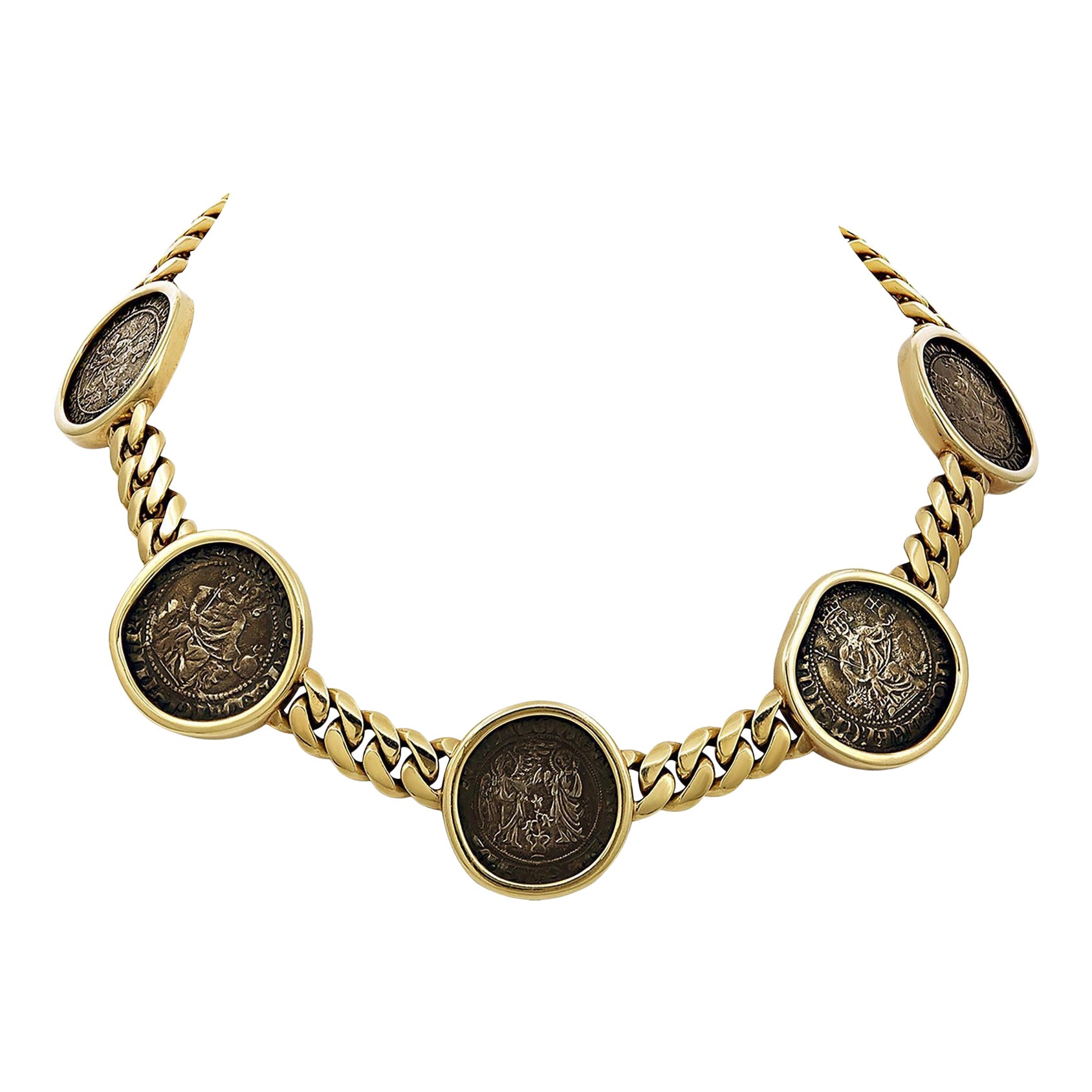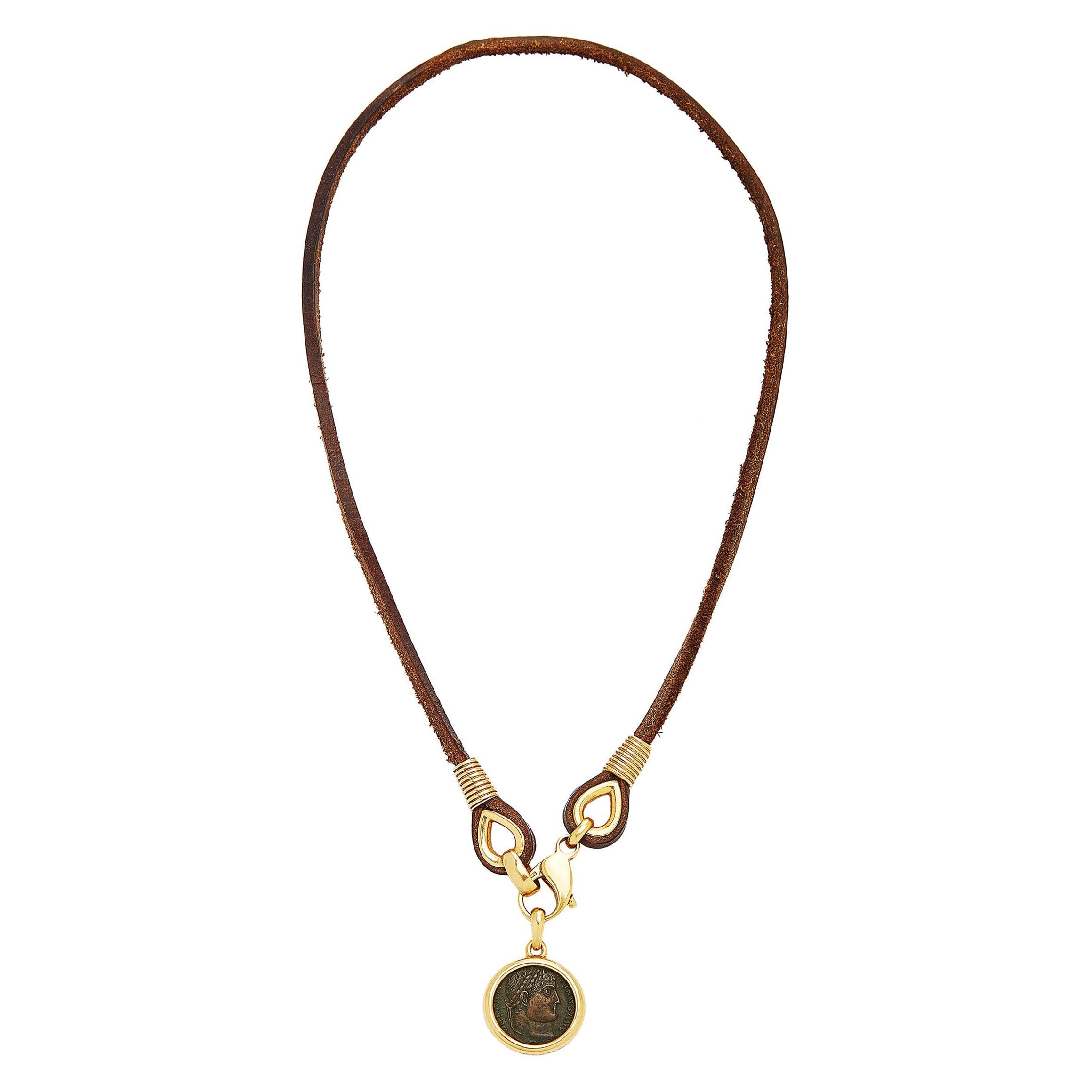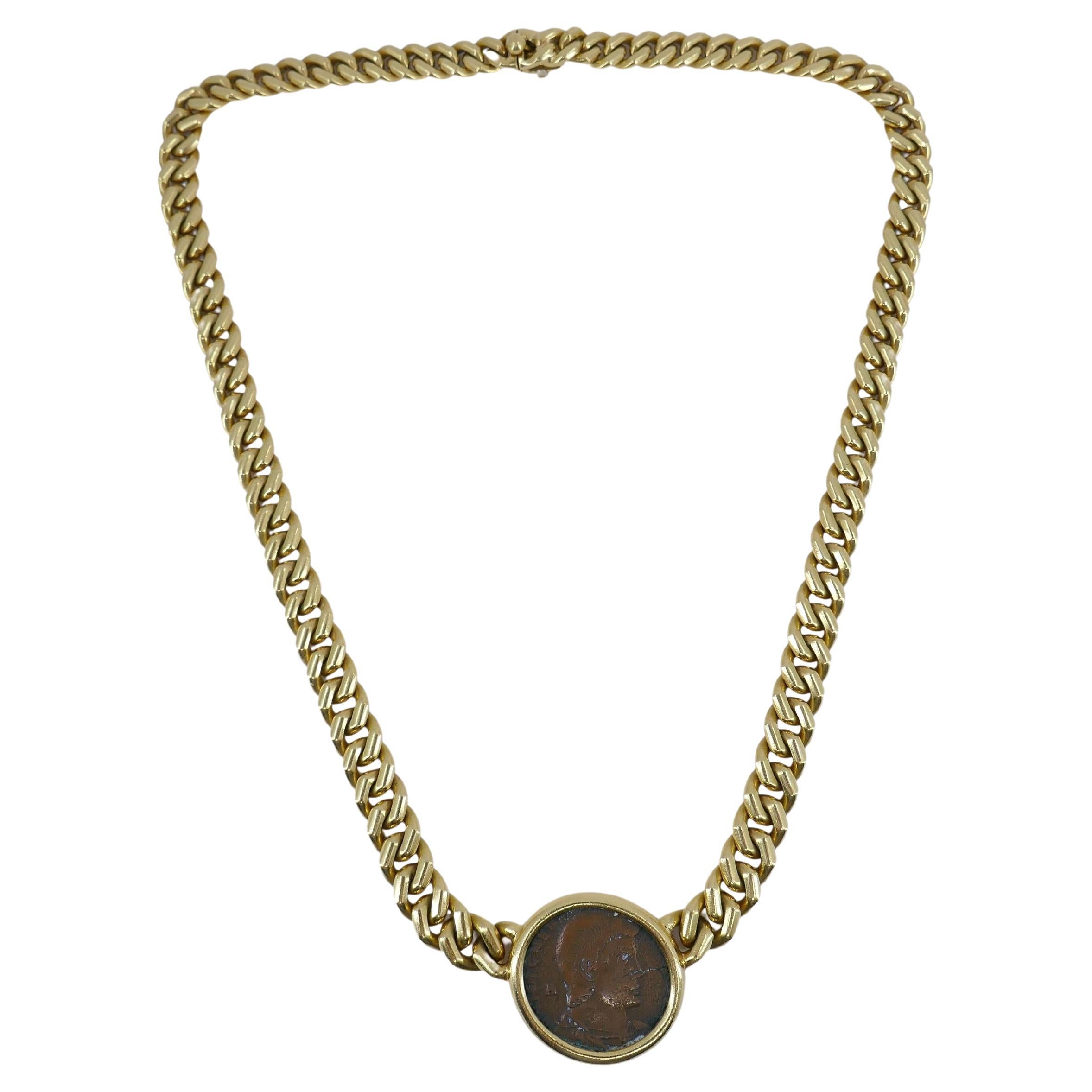Bulgari 'Monete' gold Necklace, circa 1980
About the Item
- Creator:
- Metal:
- Weight:105.9 g
- Dimensions:Length: 15.94 in (404.88 mm)
- Style:
- Place of Origin:
- Period:
- Date of Manufacture:1980
- Condition:Wear consistent with age and use.
- Seller Location:Malmö, SE
- Reference Number:1stDibs: LU3148222493282
Bulgari
Greek silversmith Sotirios Voulgaris arrived in Rome in 1881 and set up his own shop there in 1884, calling it Bulgari, an Italianization of his last name (eventually spelled BVLGARI, using the classical Latin alphabet in a nod to ancient Roman culture). In 1905, he opened the company’s flagship boutique on Rome’s Via dei Condotti.
Although the house found success with its silverwork and Art Deco designs, popular through the 1920s, its signature style — bold, often using yellow gold embellished with big colorful gemstones — began to emerge when Sotirios’s sons inherited the business, in 1932. The brand truly hit its stride in the dolce vita era of the 1950s and ’60s, when the founder’s grandsons Paolo, Gianni and Nicola Bulgari decisively departed from demure traditional styles to develop the house’s exuberant multi-gem looks, attracting celebrity collectors like Elizabeth Taylor.
In the 1940s, Bulgari debuted perhaps its most famous design, the Serpenti bracelet watch. The piece’s snakelike coils were made possible by the tubogas jewelry technique, which links a flexible series of thin horizontal bands. Both the sleek, modern tubogas construction and the sinuous snake motif continue to be synonymous with the Bulgari brand.

- ShippingRetrieving quote...Ships From: Malmö, Sweden
- Return PolicyA return for this item may be initiated within 3 days of delivery.
- Antique victorian yellow gold collar necklaceLocated in Malmö, SEA special and very modernistic design for a Victorian piece! Antique collar necklace in yellow 14 karat gold. Unmarked, lenght of necklace 39.0cm, weight 25.3 gramCategory
Early 20th Century English Late Victorian Pendant Necklaces
MaterialsGold, Yellow Gold, 14k Gold
- Vintage Carl Bucherer link necklace in two color 18 karat goldBy BuchererLocated in Malmö, SEVoluptuous vintage Carl Bucherer link necklace in two color 18 karat gold. Can be worn alternately with alternating yellow gold and white gold links on one side and yellow gold links on the other. The 80s/90s were an iconic era for the fashion world. Think Princess Di and Madonna, Sex and city and Beverly Hills 90210. All the flair of the 80s/90s that has gone full circle and could not be more right than right now. Chunky, geometric and still indeed very feminine. A necklace that can be dressed up or down for any occasion. Signed CB, width 14 mm, length 42.5 cm, Weight 66.4 g About Bucherer: Blending the art of jewelry-making with exquisite watchmaking expertise- The Bucherer Fine Jewelry story began in 1888 when Carl F. Bucherer opened his first jewelry and watch shop in Lucerne, Switzerland. Carl Friedrich and his wife Louise wanted to seize the opportunity offered by an influx of wealthy tourists who came from all over Europe to admire the Alps and take in the fresh mountain air. The Bucherer store rapidly became a synonym for quality and originality. In 1919, Carl Friedrich Bucherer made a pioneering decision. He became the first watch retailer to start manufacturing watches under his own name. The first watch collection was released in 1919 and aimed at women. Bucherer was also one of the first watch brands to adopt watch straps. Pocket watches were still the more popular option among men at the time in the early 20th century. Wristwatches were seen as jewelry and still not a common accessory among women. Bucherer also came up with unique watch strap/bracelet designs of its own. In 1924 Bucherer decided to sell watches...Category
Vintage 1980s Swiss Modern Link Necklaces
MaterialsGold, 18k Gold, White Gold, Yellow Gold
- Hermès necklace and bracelet set -1970s yellow gold nautical rope knot linkBy HermèsLocated in Malmö, SESo very fab! Rare 18K Yellow Gold Nautical Rope Link necklace and bracelet set by Hermès An 18 karat yellow gold necklace and bracelet set with rope-like links, a loop of twisted gold wire, the iconic Hermès knot...Category
Vintage 1970s French Retro Link Necklaces
Materials18k Gold, Yellow Gold
- 1970s sculptural erotic 18 karat yellow gold necklace and bracelet suiteLocated in Malmö, SEDefinitely a conversation piece. Lots of attitude without being in your face. A sculptural erotic 1970s 18K gold necklace and bracelet suite. Drawing inspiration from Jean Mahies, Jean Filhos...Category
Vintage 1970s French Retro Link Bracelets
MaterialsGold, Yellow Gold
- Antique Early 19th Century Cut-Steel NecklaceLocated in Malmö, SECut steel jewelry was at the height of fashion from the mid 1700s well into the 19th century. Originated in the 1700s. Popular from the Georgian through the Victorian eras. To make cut steel, melted horseshoe nails were formed into tiny faceted beads. Those small steel gemstone-like studs were then riveted one-by-one onto a base plate. It was an English invention that quickly travelled throughout the world. Each stud could have up to 15 facets, and in general the finer and older the piece the more facets the studs will have. Improvements in candles meant that grand events and entertaining could take place at night. As diamonds are diamonds and not available for everyone, and everyone wanted to shine, the popularity grew. Cut-steel provided a stylish and popular new jewelry material that could be enjoyed by everyone at all levels of society. It grew beyond a simple imitation to an art in its own right. The manufacturing was complex and the workmanship that was required highly skilled. These were not mass produced objects. The studs were made from decarbonated cast steel, which was case-hardened, then the studs were faceted by cutting against a pewter wheel. Next were then polished with first fine emery and a hard brush, and then by hand with a special putty. Finally they were riveted onto pierced base plates which had to be drilled and cut by hand, too. The main place of cut steel production was Birmingham, England. And there, one manufacturer stood out from all the rest: Matthew Boulton. He had been born in 1728 into the industry — his father manufactured small metal products. But the younger Boulton had a special talent for marrying the latest technology with the latest fashion. He also was continually expanding — he even founded a mint. He wined and dined with dignitaries and advocated for his steel products. Fortuitously, he became quite close with the Russian ambassador to Catherine the Great. When the ambassador toured the mint, Boulton made sure to send the Empress some of his cut-steel necklaces. In 1759, Louis XV “encouraged” the nobility to donate their gold and gemstone jewelry to help fund the Seven Years War. The popularity of cut steel in France may in part have been due to these sumptuary laws which limited who could wear precious metals and diamonds. Either you complied with the law and gave up your family jewels to be melted down for the war chest...Category
Antique Early 19th Century English Early Victorian Link Necklaces
MaterialsSteel
- Carlo Weingrill - 1970s bi-color gold tubogas necklace.By Carlo WeingrillLocated in Malmö, SEA 18 karat bi-color gold tubogas necklace By Master Carlo Weingrill circa 1970 Of graduating gaspipe-link design, in 18 Karat gold, signed Weingrill, with maker's mark for Weingrill, length 39cm The Tubogas is a flexible metal pipe patented in 1881. In the 1940s, it was discovered by jewelers, who gave it a glittering future. Tubogas changed names almost as often as a snake changes its skin: "skeleton key", "spirotube", "gas pipe", "Serpenti". But it was the Second World War that sealed its destiny. The Tubogas was originally a corrugated tube made of articulated bands used to transport pressurized gas Being one of the most characteristic and successful designs, the gold Tubogas: a flexible band of sleek and polished contours produced without soldering, a powerful representation of skill. Its construction, which requires hours of skilled craftsmanship, consists of wrapping two long strips with raised edges around a core – either of copper or wood. The edges then interlock onto another, requiring no soldering. The core is then removed, either by simply drawing it out or dissolving it in acid. The flexibility of such a gold band is truly remarkable and has been employed to great effect in the production of necklaces by single or multiple bands of Tubogas. Carlo Weingrill, undisputed maestro of golden craftsmanship, Carlo Weingrill was founded in 1879, and the number 1 piece produced, was exactly this Tubogas. In the 20's Van Cleef & Arpel made this piece even more popular, and in the late 1960's it was even further relaunched by Bvlgari, for which Carlo Weingrill has produced a large quantity of pieces. Four generations of Italian gold artisans have built a House that exemplifies fine craftsmanship, exquisite detail, and timeless design. Carlo Weingrill was born in Verona, Italy, in 1856. At the age of eleven, he began his apprenticeship in a goldsmith’s shop. Upon completing his training at the age of 22, he made the decision to open his own workshop in 1879 in Verona. Every piece was handmade using traditional artisan techniques and designed to be worn and enjoyed regularly, sing the highest quality materials coupled with exceptional craftsmanship. The business flourished, and Carlo brought his two sons, Armando and Gastone, into the business. They took over upon Carlo’s death in 1924, and grew the small artisan concern into a major player in the industry, gaining worldwide prestige for their exquisite workmanship. Upon Armando’s death in 1959, Gastone continued to carry on as head of the business. Armando’s daughter, Paola Weingrill, was the next in line to take on the business. From the time she was a toddler, Paola was fascinated with the goldsmiths and their work. When her Uncle Gastone passed away in 1977, it was Paola who took over as chief executive officer. Paola groomed her son, Carlofilippo Mensi Weingrill, to assume the reins of the company upon her retirement. Carlofilippo is now head of the firm, representing the fourth generation to head this illustrious House. From the beginning, the company employed goldsmiths who handcrafted their jewelry, eschewing the use of machines. Workers sat at a table molding, shining and polishing the gold to a stunning finish. In Italy, a craftsman could become a goldsmith after apprenticing for two years, At Weingrill, apprenticeships lasted seven years. Gold has always been the mainstay of the company, using diamonds and gemstones sparingly. The distinctive warm yellow tone of the Italian gold has become synonymous with the house. Weingrill’s goal has been to preserve their tradition of fine craftsmanship and produce wearable works of art using the finest materials, creating timeless pieces that endure for generations In time the quality of Weingrill jewels would attract the attention of some of the biggest names in 20th century fine jewelry...Category
Vintage 1970s Italian Retro Choker Necklaces
MaterialsYellow Gold, Gold, 18k Gold
- Bulgari Coin 'Monete' Necklace, circa 1980By BulgariLocated in New York, NYAn iconic necklace comprising of 5 ancient Roman coins from the Bulgari's 'Monete' collection. Metal is 18k yellow gold. Weight of the necklace is 145.27 grams. 15.5 inches long. Sta...Category
Late 20th Century Italian Contemporary More Necklaces
Materials18k Gold, Yellow Gold
- Bulgari Chunky 18 Carat Gold Fancy Link Chain Collar Necklace, circa 1980sBy BulgariLocated in London, GBA stylish and heavy gold collar necklace by Bulgari c.1980s, the necklace formed of oval cut out domed links with fine articulation and a concealed clasp, it sits around the base of the neck in a chunky collar style...Category
Late 20th Century Italian Choker Necklaces
Materials18k Gold
- Bulgari Monete Necklace Eight CoinBy BulgariLocated in Beverly Hills, CAA spectacular Bulgari Monete 18k gold necklace, featuring eight ancient Roman coins. This impressive piece is the longest among the Bulgari Monete necklaces...Category
1990s Chain Necklaces
Materials18k Gold, Mixed Metal
- Bulgari Monete Gold Ancient Coin Leather NecklaceBy BulgariLocated in New York, NYA Bulgari "Monete" necklace in 18kt yellow gold with leather cord and an ancient Roman coin (inscribed TICINUM CONSTANTINUS AUG A.D. 307-337). Made in Italy, circa 1970s.Category
Vintage 1970s Italian Drop Necklaces
MaterialsGold, 18k Gold
- Bulgari Monete Gold Necklace Ancient Roman CoinBy BulgariLocated in Beverly Hills, CAAn iconic Bulgari Monete 18k gold necklace, featuring an ancient Roman coin. The coin is depicting emperor Magnentius, AD 350-353. It's bezel set and attached to the curb link chain....Category
Vintage 1970s Chain Necklaces
MaterialsGold, 18k Gold
- Bulgari French 1980's 18 Karat Tri-Gold Geometric Vintage Collar NecklaceBy BulgariLocated in Philadelphia, PADesigned as a collar necklace comprised of fitted forms in tri-gold Rose gold forms are dimensional faceted pyramids Yellow gold forms are sweeping chevrons White gold forms are curv...Category
Vintage 1980s Contemporary Link Necklaces
MaterialsGold, 18k Gold, Rose Gold, White Gold, Yellow Gold






